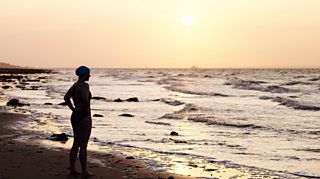The first woman to swim the English Channel
In the ÃÛÑ¿´«Ã½ Radio 4 podcast History’s Heroes, Alex von Tunzelmann looks at extraordinary true stories from across history of people with purpose, brave ideas, and the courage to stand alone.
American swimmer Gertrude Ederle was a teenager when she made her first attempt to swim the English channel in 1925 – a feat that at the time had only been successfully completed by five men.
Not only did she have to take on extraordinary physical challenges, including her own disability: she also had to deal with a coach who she believed was trying to sabotage her.
Who was Gertrude Ederle?
She was born in 1905 to German immigrants in New York. The year before she was born, a maritime disaster devastated their Lutheran community. A passenger steamboat, the General Slocum, was ferrying churchgoers to a picnic when it caught fire and sank in the East River of New York. More than 1000 people were killed, mostly women and children. It was unusual for women to learn to swim at the time, and the heavy woollen clothes they wore dragged them beneath the waves. Gertrude’s parents were determined she would learn to swim as she grew up. But a bout of measles when she was five left her with progressive deafness, and doctors advised against her spending long periods of time in the water. She pleaded with her parents and was eventually allowed to swim, at first with a clothesline tied around her waist and her father holding the end.
How did she come to attempt the English Channel swim?
As a young teenager, she joined the New York Women’s Swimming Association. She represented the United States at the Paris Olympics in 1924, but afterwards wasn’t chosen as the Women’s Swimming Association candidate to become the first woman to swim the English Channel. Her opportunity came when the chosen candidate had to pull out with an injury.

Why did she clash with her coach?
The Association hired a Scottish swimmer, Jabez Wolffe, as her coach. He’d attempted the channel swim more than 20 times himself, but had never completed it. He thought Ederle was stubborn and wouldn’t listen to him; she found him overbearing and jealous. He wanted her to swim breast-stroke across the channel, which would mean a much slower time. She preferred her favourite faster stroke, front crawl.
She alleged that Wolffe had deliberately sabotaged her attempt – spiking her beef broth, and pulling her from the water when she could have carried on.
How did her first attempt begin?
On 18 August 1925, Wolffe gave Ederle beef tea to drink. She swam out from Cap Gris-Nez in Northern France, accompanied by support swimmers. A tugboat followed, packed with journalists and even a four-piece band playing music to keep everyone’s spirits up. But Ederle began to feel woozy. She thought the beef tea Wolffe had fed her tasted strange, and suspected he’d spiked it with alcohol. It wasn’t unusual at the time for swimmers to have a shot of brandy to keep warm, but this wasn’t what they’d agreed.
Why did it end early?
Eight hours and 43 minutes in, Ederle hit rough seas. As the tugboat lurched and the musicians and journalists succumbed to seasickness, she took in a huge gulp of water. Wolffe cried, “She’s drowning!” He demanded one of her supports, the Egyptian swimmer Ishak Helmi, grab her and pull her to safety. Helmi did – but the fact another swimmer touched her immediately disqualified her under the rules of the swim.
What did Ederle do next?
She alleged that Wolffe had deliberately sabotaged her attempt – spiking her beef broth, and pulling her from the water when she could have carried on. Her chaperone agreed, claiming that she’d heard Wolffe give exactly these instructions. Though the claims against him remained unproven, they didn’t work together again. She hired a new coach, Bill Burgess, who had become the second man to complete the channel swim in 1911. She funded this herself with press deals and a position as a swimming performer and instructor at a hotel in Miami, Florida.
When did she make her second attempt?
On 6 August 1926, Ederle swam out into the English Channel again. This time she was wearing a swimsuit of her own design – a silk two piece, which left her midriff bare and allowed her to propel herself through the water faster. She also adapted her goggles with wax so that salt water didn’t leak into her eyes.

How did it go?
The sea was turbulent that day, but Ederle was determined to continue whatever happened. Her father had promised her a red roadster if she completed the swim, and the support crew on the boat held up signs at various points stating the names of parts of a car, shouting out “You’ve got a wheel!” or “You’ve got a bonnet!” Fourteen hours and 31 minutes after setting out, Ederle reached Kingsdown on the English coast. If the weather hadn’t blown her off course and she could have swum in a straight line, it would have been 21 miles between France and England. But conditions were so difficult that it’s thought she swam more like 35 miles. Not only was she the first woman to swim the English Channel: she also smashed the world record time set by the men who had gone before her by two hours.
What did she do afterwards?
Ederle was honoured with a ticker-tape parade in New York, a visit to the White House – and a spate of marriage proposals. During the 1920s, she helped inspire more than 60,000 women throughout the United States to earn Red Cross swimming certificates. She never accepted any of the marriage proposals, and instead lived in Queens, New York, with two female companions. She died in 2003 at the age of 98.


